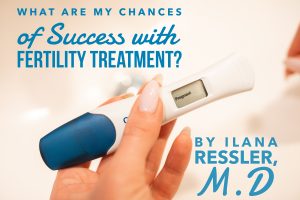What Are My Chances of Success with Fertility Treatment?

By Ilana Ressler, M.D, Reproductive endocrinologist at RMA of CT
We see the heartwarming pictures often: the baby in a onesie that says, “Made with love and a little bit of science.” We love those photos for so many reasons.
Babies are our goal.
Love is invaluable.
And science is powerful.
As a reproductive endocrinologist, I see every day how difficult it can be to build a family. My goal is to do everything in my skillset to bring my patients across the finish line, which in reality, is the start of their lives together with a new baby. With today’s advanced technology, we are successful, more often than not. We have thorough testing, expansive treatment options, and hyper-focused experts in place to make sure on the medical end, the “science” part of it all, we give the patient the highest chance for success.
Add in the immense work, love, and determination from the patient, and many times, we receive that card in the mail with the baby introduction. “Made with love and a little bit of science.”
One of the hardest conversations I have to have as a physician, however, comes well before the injections or the pregnancy tests. It’s when I have to tell every patient that walks through my door that assisted reproductive technology (ART) is not a guarantee for anyone. As an ethical, responsible doctor, I cannot promise you a baby. I can promise science, innovative technology, and problem-solving. But I can’t give you a guarantee.
To help me explain why ART is never a guarantee to have a baby, I will use data gathered by a trusted source for our industry, called the Society for Assisted Reproductive Technologies, or SART.
What is SART?
SART is focused on providing truthful data, success rates, and clinical options for any patient entering the world of fertility assistance. They collect data from over 85% of the nation’s IVF Centers, organize it in clear “snapshot” reports, thus providing patients with an idea of how their age-range and cycle-type performs at a particular center. A SART clinic is considered to be an honest clinic, as they must report truthful data, all the successes and otherwise, and must use nationally accredited laboratories. These clinics are committed to serving the highest-quality care possible.
Setting the Stage for Success
Before we dig into the data, there are a few considerations to go over so that you truly understand the realistic likelihood of how well these individual treatments work on different group sets.
The Basics
Age
This is a big one, as the age of the egg is one of the most important predictors of success. Women are born with a finite number of eggs, and that supply runs out at menopause. Well before this, there is an effect of age on fertility, statistically seen starting in our mid-30s. Being less than 35 years old puts someone in the best prognosis category, and there is a slow decline in success from that point. This is due not only to a decline in the quantity of eggs, but also quality.
A normal egg has 23 chromosomes, and as women age, an increasing number of eggs have either more or less than 23 chromosomes, which means that if fertilization occurs, the embryo will be aneuploid (too many or too few chromosomes). As we age, the ratio of “good” to “bad” eggs decreases, meaning higher rates of negative outcomes, miscarriages, and aneuploidy. Ultimately it can be thought of as a numbers game, and it’s all about finding that “golden egg.”
Age also affects male fertility, but in a much slower, more subtle manner. Sperm quality does decline with age, but typically is not a problem before the age of 60. Even with these changes, there is no male “menopause” or maximum age to father a child. There are additional genetic risks associated with advancing paternal age.
BMI
Having a healthy body mass index (BMI) is important when trying to conceive. A BMI of 19 to 24.9 is considered normal, less than 19 underweight, between 25-29.9 overweight, and anything greater than 30 is considered obese. Studies have shown that obesity decreases the chances of success with ART. Obese women have lower pregnancy rates and higher miscarriage rates. There are additional pregnancy-related risks associated with obesity, including gestational diabetes, gestational hypertension, and preeclampsia, a higher rate of needing a cesarean section, and some birth defects. Obesity in men may be associated with changes in testosterone and other hormone levels, as well as lower sperm counts and motility.
If your weight is in the obese category, it is important to discuss it with your physician. Depending on other factors, including age, it might be recommended to attempt safe, balanced weight management prior to fertility treatment and/or seek assistance. You should also consult with your fertility practice on their BMI limitations for treatment. For example, at RMA of Connecticut, achieving a BMI less than 45 is needed prior to starting an IVF cycle and less than 50 prior to an ovulation induction cycle to decrease the risk of medical complications.
Lifestyle Habits
Other Influencers of Success to Keep in Mind
There are more factors that can directly or indirectly affect your family building success. In addition to the basic influencers above, the below categories are constantly being studied and more understood in connection with fertility.
Odds for Success in Assisted Reproductive Technologies
So, back to SART and how you can use the data to better understand the realistic chances of having a baby…
Let’s walk through what the data says about different age groups, different hurdles, and different pathways together. We will keep in mind the above influencers of fertility so that you can more accurately see where you might fall in the spectrum.
IVF Success Rates: A Breakdown
The below data points are pulled directly from the 2018 Clinic Summary Report, meaning they are specific to RMA of Connecticut from all IVF cycles conducted during the 2018 year. That may seem outdated, but the 2018 data set is actually the most current and accurate set SART has to date. Keep in mind that it takes a long time to fully acquire the data from a year’s worth of cycles – some people freeze embryos for later usage and pregnancy itself takes a while. So all the cycles conducted in 2018 won’t have been necessarily completed for quite some time after 2018.
Knowing that the 2018 numbers are the most up to date, let’s dig in:
Live singleton births per new patient, using own eggs at RMA of Connecticut (In other words, the odds of you having a baby, using your own eggs in an IVF cycle at our practice, are as follows):
Under 35 = 68.2%
35-37 = 68.2%
38-40 = 39.8%
41-42 = 17.4%
42+ = 4.2%
If you would like to dig a little deeper into the data or to see national averages of these same demographics, I highly recommend visiting sart.org directly and utilizing their interactive data tool. You can specify if you are using your own eggs or donor eggs/embryos, look up information on implantation rates, and even use the success rates of various clinics to help determine which practice you choose to help with your family building.
Be sure to evaluate each clinic’s data against the SART National Data, as locations, demographics, and other situational factors aren’t the same across the board, and therefore, offer an unclear comparison clinic to clinic.
IUI Success Rates
The success rates of intrauterine insemination (IUI) cycles are not reported to SART. Typically they range from 5-15% per cycle, depending on the situation. Once again, age plays a big role in predicting success. Other important factors include the underlying diagnosis, a patient’s specific medical history, and the medication being used to stimulate the ovaries.
How Do I Increase My Chances of Success
Simply, the way to increase your chances of success is to take advantage of what is in your control. Calling back on my previous statements about lifestyle choices, nutrition, and physical movement, allow these influencers to work for you as opposed to against you. Together with your fertility team, you can come up with a plan to increase your odds.
At RMA of Connecticut, our patients have access to the Integrated Fertility and Wellness Team which is meant to supplement the fertility process by taking care of the mind and the body. We believe acupuncture, counseling, nutritional guidance, and movement, all disciplines within our IFW team, are critical to the overall experience, and ultimately, success.
If your practice does not have an in-house team dedicated to treating the whole person, beyond the typical protocol, ask them for local recommendations for these types of mind/body connectors. Not only is it scientifically proven to help your treatment (did you know laser acupuncture before and after your embryo transfer can up your chances of implantation success by 15%?), it’s a great help in clearing your mind, sharing with others, and learning more about yourself.
How Can I Predict My Success With Fertility Treatments?
It’s important when entering the fertility journey and using treatments like IVF or IUI to know that science, your doctors, and your support systems will do everything they can to achieve your dreams of growing your family. And while there is no guarantee with any procedure, knowing where you fall in the percentages is helpful to understanding the realities of the entire situation.
Having presented you with all the scientifically backed data, there is a tool on the SART website that will help you get a sense of where you land in the spectrum, sharing what your personal odds might look like. Remember, this is just a simple online tool and not a substitute for a full fertility evaluation. Only after a full diagnostic workup and an appointment with a fertility specialist can you understand the full scope of what your specific odds are. Let me assure you, though, that no matter if your likelihood of becoming pregnant with your own eggs or sperm is 1%, our team at RMA of Connecticut will do everything we can to make it happen.
All this data speak is nothing without hope and love. That’s why it’s so important to take care of your mind and body while going through treatment, because sometimes, these numbers can be overwhelming and diminish hope. I highly encourage you to pursue acupuncture, counseling, movement, and support groups.
If you bring the passion, your reproductive endocrinologist will bring the science.
ABOUT THE AUTHOR
Dr. Ilana Ressler is a Reproductive endocrinologist, and is board-certified in both Obstetrics and Gynecology and in Reproductive Endocrinology and Infertility. Dr. Ressler serves as Medical Advisor for Yesh Tikva, which was established to create a Jewish community of support for those experiencing infertility. She also launched the Pies for Prevention program in her Westchester community to benefit Sharsheret, the nonprofit organization supporting Jewish women and families facing breast and ovarian cancer. Dr. Ressler lives in Westchester, New York with her husband and three young children.
Disclaimer: The views and opinions expressed in this article are those of the authors and do not (necessarily) reflect the views of PregnancyJournal.com. PregnancyJournal.com can in no way whatsoever be held responsible for the content of such views nor can it be held liable for any direct or indirect damage that may arise from such views.
This article was originally published by RMA of CT




